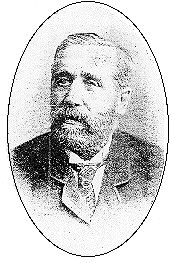Henri D'Alcorn
This article was written in 1995 based on sources that have since proved unreliable in some respects, although it gives a reasonable impression of the overall arc of D'Alcorn's career. Research is under way to produce a more accurate version.

Henri D'Alcorn (1827–1905)
from his obituary in The Era
In 1858 a new dance craze hit London. A cross between a waltz and a polka, 'La Varsoviana' was taught to thousands at a time by the Chubby Checker of his day, Henri D'Alcorn, who now rests in St Pancras & Islington Cemetery.
Henri was born George Henry Stannard Allcorn in 1827. His father had a medical-supplies business, and the young Henry worked part-time in the family truss works.
In 1845 he became a student at Guy's Hospital, but his great passion was music, and especially dancing, and in autumn 1846 he slipped off to Paris for a dance weekend. This was so enjoyable that, back in London, he enrolled with the leading dance academy of Gouriet & Franconi, and was soon declared to be 'better than his tutors'.
In late 1847 Henry finally abandoned medicine and became master of ceremonies at the Argyle Rooms in Covent Garden, leading the dancing at all-night masked balls. He was well paid and in his element.
In 1858 he took a new job at the Highbury Barn pleasure gardens, where the gaslit 'Leviathan' dance-floor that could hold 2,000 dancers had just been built. With the move came a change in name – to the more impressive Henri D'Alcorn.
It was now that he introduced 'La Varsoviana' to the London public. (He himself had learned it in Paris shortly before.) It was a great success, and sales of the music, printed by Henri, were excellent too.
He had already been publishing music for a few years, and now decided to do so full-time, selling direct to the public and concentrating on music-hall numbers, which had a fast turnover.
To keep new songs coming, he made agreements with the music-hall artistes who wrote most of them, introducing colour pictures of the performers in their stage outfits on the covers. (Songs he published included 'Two Little Girls in Blue', 'Hampstead is the Place to Ruralise' and 'She was Fat, She was Fair, She was Forty'.) When competitors started pirating his numbers, he studied law and became an authority on copyright.
In 1872 Henri gave up his retail business, and in 1877 he began to dispose of his other music interests and moved to a farm in Lincolnshire. But he still had contacts in show business, and in 1891 he heard about a new song by Henry J. Sayers. This had flopped in the USA, but, properly marketed, it might succeed in the UK. Henri saw its potential and bought subsidiary rights. He interested a music-hall artiste called Lottie Collins in including it in her next show, and 'Ta-ra-ra Boom-de-ay!' – with a saucy swing of the hips on 'Boom' – then became an enormous hit: 100,000 copies of the music were sold in the first five days alone.
This encouraged Henri to re-enter music publishing. But times had changed, and in 1899 he became bankrupt and moved into a son's house in Herne Hill. (He fathered eleven children during three marriages – the second 'unofficial', as his first wife refused him a divorce. This article is based on material kindly supplied by a great-grandson, Eric D. D'Alcorn.)
He died in 1905 and was buried alongside his parents in a plot he had bought for them in St Pancras & Islington Cemetery. His last wife, Mehetabel, joined them in 1937.
Personal communication from Eric D'Alcorn
Obituary in The Era, 10 June 1905